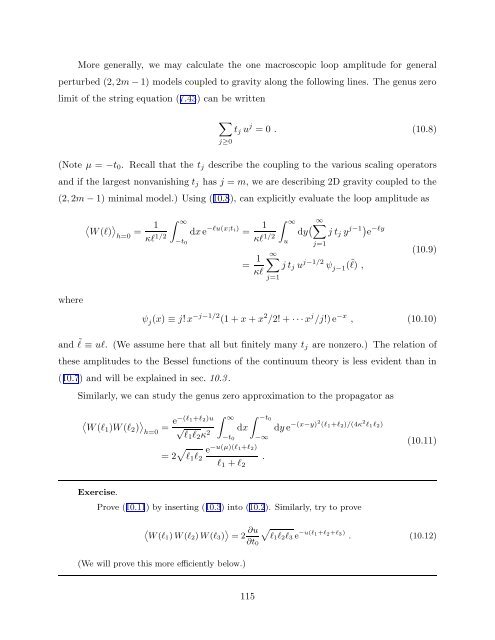arXiv:hep-th/9304011 v1 Apr 5 1993
arXiv:hep-th/9304011 v1 Apr 5 1993
arXiv:hep-th/9304011 v1 Apr 5 1993
Create successful ePaper yourself
Turn your PDF publications into a flip-book with our unique Google optimized e-Paper software.
More generally, we may calculate <strong>th</strong>e one macroscopic loop amplitude for general<br />
perturbed (2, 2m − 1) models coupled to gravity along <strong>th</strong>e following lines. The genus zero<br />
limit of <strong>th</strong>e string equation (7.43) can be written<br />
∑<br />
t j u j = 0 . (10.8)<br />
j≥0<br />
(Note µ = −t 0 . Recall <strong>th</strong>at <strong>th</strong>e t j describe <strong>th</strong>e coupling to <strong>th</strong>e various scaling operators<br />
and if <strong>th</strong>e largest nonvanishing t j has j = m, we are describing 2D gravity coupled to <strong>th</strong>e<br />
(2, 2m − 1) minimal model.) Using (10.8), can explicitly evaluate <strong>th</strong>e loop amplitude as<br />
〈<br />
W (l)<br />
〉h=0 = 1 ∫ ∞<br />
dx e −lu(x;ti) = 1 ∫ ∞<br />
dy ( ∑<br />
∞ j t<br />
κl 1/2 −t 0<br />
κl 1/2 j y j−1) e −ly<br />
u j=1<br />
= 1 ∞∑<br />
j t j u j−1/2 ψ<br />
κl<br />
j−1 (˜l) ,<br />
j=1<br />
(10.9)<br />
where<br />
ψ j (x) ≡ j! x −j−1/2 (1 + x + x 2 /2! + · · · x j /j!) e −x , (10.10)<br />
and ˜l ≡ ul. (We assume here <strong>th</strong>at all but finitely many t j are nonzero.) The relation of<br />
<strong>th</strong>ese amplitudes to <strong>th</strong>e Bessel functions of <strong>th</strong>e continuum <strong>th</strong>eory is less evident <strong>th</strong>an in<br />
(10.7) and will be explained in sec. 10.3 .<br />
Similarly, we can study <strong>th</strong>e genus zero approximation to <strong>th</strong>e propagator as<br />
〈<br />
W (l1 )W (l 2 ) 〉 h=0 = e−(l 1+l 2 )u<br />
√<br />
l1 l 2 κ 2<br />
∫ ∞ ∫ −t0<br />
dx<br />
−t 0 −∞<br />
= 2 √ l 1 l 2<br />
e −u(µ)(l 1+l 2 )<br />
l 1 + l 2<br />
.<br />
dy e −(x−y)2 (l 1 +l 2 )/(4κ 2 l 1 l 2 )<br />
(10.11)<br />
Exercise.<br />
Prove (10.11) by inserting (10.3) into (10.2). Similarly, try to prove<br />
〈 W (l1 ) W (l 2 ) W (l 3 ) 〉 = 2 ∂u<br />
∂t 0<br />
√<br />
l 1 l 2 l 3 e −u(l 1+l 2 +l 3 ) . (10.12)<br />
(We will prove <strong>th</strong>is more efficiently below.)<br />
115
















